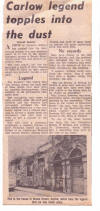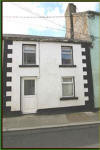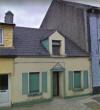Memories of one of the oldest and most historic landmark
buildings in Carlow town is so prevalent that it’s hard to recognise
the real history of the town.
We highlight her writings about the Carlow Workman’s Club and its
proud past.
“The Carlow Workman’s Club is the only one of the four large early
Georgian double houses which has survived the ravages of time. The
Carlow Workman’s club was founded in 1899 and the first meeting of the
newly elected committee was held in the present premises.
“It was decided to purchase the following club requisites: draught
board and men, two packs of cards, one box of dominoes, card book and
secretary’s account book.
“It was also agreed to purchase two dozen chairs of Irish manufacture
from Mr Thomas Richards at 3/3d each. It was disclosed later that the
chairs supplied were not of Irish manufacture and a lot of
correspondence took place about them.
“Card playing was charged at one penny per sitting only 15s and 25s
permitted. Any member who broke any of the rules was expelled.
“It was decided to purchase a lamp and bracket from Mr Hennessy for
£2 12s 0d and have it erected over the entrance the name in English on
one side and the equivalent in Irish on the opposite.
During the War of Independence the Club was used by the IRA as a
secret meeting place, here plans were made and orders issued to members.
“The house beside the Workman’s Club can only be dated back to 1883
but of course its history goes back much further to the 1700s. I have
tried to find out who built these four houses and who were the first
tenants but I have not been successful.
“The first offices and printing works of The Nationalist were in this
house. It was founded in 1883 by the late Mr Patrick Conlan who felt
there was a great need of a local nationalist paper to offset the views
of the conservative Sentinel.
“During the bad years of 1888 and ‘89 the tenants of Carlow, Kildare
and Leix petitioned the landlords for a reduction of their rents. They,
the landlords, refused and like Shylock they demanded their “pound of
flesh”. Evictions followed, the worst area was Luggacurran, Leix.
“Mr Conlan took up the cause of the evicted tenants and wrote about
their sufferings in his paper in January and February, 1889. He was
arrested on a charge of seditious writing and tried at Carlow Petty
Sessions, March 23 1889.
“He refused to give bail and was sentenced to two months imprisonment
and was lodged in Kilkenny jail. Mr Conlan was released from jail on May
20, 1889. The Mayor of Kilkenny escorted him to the station and there
was a big crowd waiting for him in Bagenalstown where he addressed them.
“He was met on the arrival of the train to Carlow station by the new
Carlow-Graigue Brass Band, headed by the banner of the Bennekerry and
Tinryland National League and escorted to his residence in Browne Street
where he addressed his supporters.
“On the following Sunday May 26 Mr. Conlan was entertained to a
banquet in Tynan’s Hotel (where the Ritz Cinema was). The chair was
occupied by Rev Fr Kavanagh, Vice Chairman, Mr. Thomas Keogh. Park Covers
were laid for 70 guests. Some fine songs were given during the evening
to intersperse the speeches. The accompaniments were played by Professor
McAlinden, organist to Carlow Cathedral.”
Carlow legend topples into
the dust.
Herald Special
 A
piece of Carlow's history has toppled into the dust, leaving
behind it a vast question mark. It is one of the former tenement
houses in Brown Street which stood idle and derelict for several
years. The local council has just demolished a block of these
houses in order to leave an open space which will probably
become car park.
The
legend
The mystery? The legend that was
written across the back wall of what might once have been an
upstairs drawing-room: poor children of all persuasions educated
here.
The inscriptions only came to light recently after the roof had
caved-in and the weather had thoroughly scrubbed the wall. Just
before demolition it was only barely legible and a camera man
had to borrow a ladder from the workman's club next door in
order to get a picture of the legend.
Was this once a children's workhouse,
a common feature in early Victorian times? An alms house? or an
orphanage? Several Old Carlow Society experts were quizzed and
each of them came up against the same mysterious brick wall each
time.
A
piece of Carlow's history has toppled into the dust, leaving
behind it a vast question mark. It is one of the former tenement
houses in Brown Street which stood idle and derelict for several
years. The local council has just demolished a block of these
houses in order to leave an open space which will probably
become car park.
The
legend
The mystery? The legend that was
written across the back wall of what might once have been an
upstairs drawing-room: poor children of all persuasions educated
here.
The inscriptions only came to light recently after the roof had
caved-in and the weather had thoroughly scrubbed the wall. Just
before demolition it was only barely legible and a camera man
had to borrow a ladder from the workman's club next door in
order to get a picture of the legend.
Was this once a children's workhouse,
a common feature in early Victorian times? An alms house? or an
orphanage? Several Old Carlow Society experts were quizzed and
each of them came up against the same mysterious brick wall each
time.
No Records
Miss Alice Tracey of the Old
Carlow Society, said the problem had intrigued her for a long
time but her research had been foiled by the absence of any
records relating to the building.
"I suspect, without being anything
like certain, that it may have been a Quaker refuge for
children" she said. "But the Society of Friends in Carlow is
gone now , and any records that may have been kept with regard
to the house have so far eluded all searches."
Miss Treacy, however, was most
instructive about the other houses involved in the demolition.
"The house at the corner of Charlotte Street," she said, "was
the town house of Brown-Claytons, whose country seat was at
Brownes Hill and who have now moved to the West of Ireland.
"In one of the other houses was born
the late Coadjutor Bishop of Leighlin Dr. Comerford, whoes
family kept a pawnshop next door at the time of his birth.
Caption
under picture: This is the house in Brown Street, Carlow, which
bore the legend that no one could solve.Source:
Peter Walker 2016

Brown Street |

Brown Street |

The Dolls House. Brown Street |